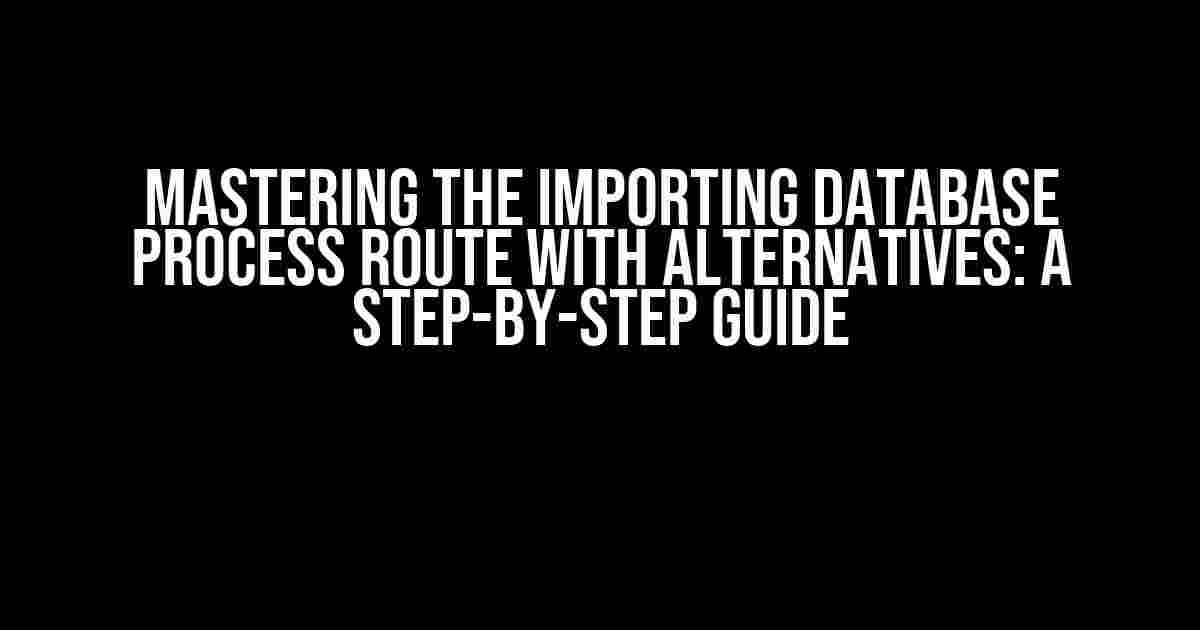Are you tired of struggling with importing databases, only to encounter errors and roadblocks along the way? Fear not, dear database administrator, for we’re about to embark on a journey to conquer the importing database process route with alternatives. Buckle up, and let’s get started!
Understanding the Importance of Importing Databases
Importing databases is a crucial step in various scenarios, such as:
- Migrating to a new database management system (DBMS)
- Upgrading or downgrading database versions
- Moving databases between environments (dev, staging, prod)
- Creating backups and restoring data
- Integrating with third-party applications or services
In each of these scenarios, it’s essential to have a solid understanding of the importing database process to avoid data loss, corruption, or inconsistencies.
The Traditional Importing Process: Benefits and Drawbacks
The traditional importing process typically involves:
- Exporting the database from the source system
- Transferring the exported data to the target system
- Importing the data into the target database
This process has its benefits, such as:
- Wide compatibility with various DBMS
- Familiarity and ease of use for many database administrators
However, it also has some significant drawbacks:
- Time-consuming and resource-intensive
- Prone to errors and data inconsistencies
- Limited flexibility and customization options
Exploring Alternatives: Modern Importing Methods
Fear not, dear reader, for there are modern alternatives to the traditional importing process that can alleviate its drawbacks. Let’s explore some of these alternatives:
1. Using Database Migration Tools
Tools like Apache NiFi, AWS Database Migration Service (DMS), and Talend offer a more streamlined and automated approach to importing databases. These tools provide:
- Faster migration times
- Real-time data replication
- Automated data transformation and mapping
- Support for various DBMS and data formats
-example code snippet-
nifi.data.information.insert into table_name
(column1, column2, column3)
values
('value1', 'value2', 'value3');
2. Leverage Cloud-Based Services
Cloud-based services like Amazon S3, Google Cloud Storage, or Microsoft Azure Blob Storage provide a scalable and secure way to store and transfer database files. These services offer:
- Highly available and durable storage
- Fast data transfer speeds
- Integration with various DBMS and data formats
- Cost-effective pricing models
3. Utilizing Containerization and Orchestration
Containerization using Docker and orchestration with Kubernetes can simplify the importing process by providing a:
- Consistent and reproducible environment
- Easy-to-use and scalable deployment model
- Efficient resource utilization
- Faster deployment and rollback of database changes
// Dockerfile example
FROM ubuntu:latest
RUN apt-get update && apt-get install -y postgresql
ENV POSTGRES_USER=myuser
ENV POSTGRES_PASSWORD=mypassword
ENV POSTGRES_DB=mydb
EXPOSE 5432
CMD ["postgres"]
4. Employing Data Integration Platforms
Data integration platforms like Informatica PowerCenter, Microsoft SQL Server Integration Services (SSIS), or Talend offer a:
- Unified and graphical interface for data integration
- Wide range of connectors and adapters for various DBMS
- Real-time data integration and synchronization
- Advanced data transformation and mapping capabilities
| Data Integration Platform | Features | Pricing |
|---|---|---|
| Informatica PowerCenter | Real-time data integration, advanced data transformation | $10,000 – $50,000 per year |
| Microsoft SQL Server Integration Services (SSIS) | Real-time data integration, advanced data transformation | $2,000 – $10,000 per year |
| Talend | Real-time data integration, advanced data transformation, open-source | Free – $2,000 per year |
Best Practices for Importing Databases with Alternatives
When using these modern importing methods, keep the following best practices in mind:
- Plan and test your import process thoroughly
- Use version control and change management for database changes
- Monitor and log import progress and errors
- Optimize database performance and indexing
- Ensure data consistency and integrity
Conclusion
Mastering the importing database process route with alternatives requires a deep understanding of the traditional importing process, its drawbacks, and the modern alternatives available. By leveraging these alternatives and following best practices, you can streamline your importing process, reduce errors, and increase efficiency. Remember, the key to success lies in planning, testing, and adapting to your specific database needs.
Now, go forth and conquer the world of importing databases with ease and confidence!
Frequently Asked Question
Get ready to unravel the mysteries of importing database process routes with alternatives! Here are some frequently asked questions to guide you through this complex process.
What is the first step in importing a database process route with alternatives?
The first step is to identify the source database and the target database, and ensure that you have the necessary credentials and access to both databases. This will allow you to connect to the databases and transfer the data successfully.
What are the common alternatives to traditional database import methods?
Some common alternatives to traditional database import methods include using cloud-based data integration platforms, APIs, and ETL (Extract, Transform, Load) tools. These alternatives can offer more flexibility, scalability, and automation, making the import process faster and more efficient.
How do I handle data inconsistencies during the import process?
To handle data inconsistencies, it’s essential to perform data validation and data cleansing before importing the data. This can be done using data quality tools or by writing custom scripts to identify and correct inconsistencies. Additionally, it’s crucial to have a rollback plan in place in case the import process fails or data corruption occurs.
What are the benefits of using automation tools for importing database process routes?
Automation tools can significantly simplify and accelerate the import process, reducing the risk of human error and increasing productivity. They can also provide real-time monitoring, scheduling, and notifications, making it easier to manage and track the import process.
How can I ensure data security during the import process?
To ensure data security, it’s crucial to use secure protocols for data transfer, such as SSL or TLS. Additionally, you should implement access controls, encryption, and authentication mechanisms to restrict access to authorized personnel only. Regularly reviewing and updating security policies and procedures is also essential.

